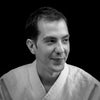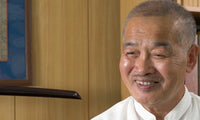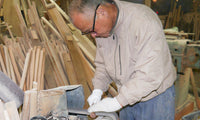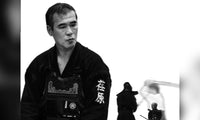Clarifications on the origin of the character "Bu" "武"
The background of a false interpretation
In Asia as in the West, we often speak of the first Kanji of "Budo" (武道), the "Bu" (武), meaning "stopping the spear". This is an interpretation that dates back almost to the origin of Budo, that aimed to draw the picture of peaceful martial arts, ignoring historical facts. Let's go back to the origins of the term to determine its true meaning.

Kanji bu artistic calligraphy by sho.goroh.net
The current use of the Kanji "Bu" and its origin
The Kanji are the Chinese characters brought to Japan and introduced into the Japanese language through Buddhism around the 6th century.
First reserved to the religious community and literary figures and from there, spreading gradually at the pace of the alphabetization of the population.
The introduction of the Chinese characters into the pre-existing Japanese language, was achieved in three ways. First, adapting the Kanji closest to both, sound and meaning, then in terms of meaning and finally terms of sound. Many sounds did originally not exist in Japanese, but got integrated into the language to facilitate the implementation of the Kanji. We thus find words with the same meaning, but two different origins, "words of Yamato" (ancient Japan) and "Chinese words" from Chinese.
Let's add an example. Derived from the Kanji "fue/zou" (増) meaning "increase", the form "Fueru" (増える), the verb "to increase", and "Zouka" (増加) "increase" as noun were created. "Fueru" already existed in Yamato, before the Kanji was introduced, and it was arbitrarily determined that this Kanji could be read "Fue", while "Zo" from "Zouka" is derived directly from the Chinese pronunciation.
The multiple pronunciations that a single Kanji can have, are the result of the "forced" introduction of the Kanji into the Japanese language. Not everything could be adapted, syllabic Kana alphabets (Hiragana and Katakana) to modify the function of a word (verb, noun, adjective) got added, whilst the religious and official texts were still written entirely in Kanji over an extended period. (This is no longer the case and there are few Japanese who would be able to read a text containing no Kana.)
The Kanji "Bu" has its roots in China, it was designed before the 6th century, at a time when violence, terror and wars reigned.
From there brought to Japan when the Chinese writing got simplified and evolved very little in the centuries to come.
It can be found in Japanese in terms much older than "Budo", for example "Bujutsu" (武術) (war techniques), "Bugei" (武芸) (art of war), "Bushi" (武士) (soldier), "Buki" (武器) (weapon), etc.
Taking this into account, it is difficult to justify a "peaceful" interpretation of this Kanji by historical facts. But back to its composition to see more clearly.
The composition of the Kanji "Bu"
The Kanji "Bu" is a so called "Kai Moji", meaning the combination of two Kanji to form a third one with the cumulative sense of the first two.
It was found in its primary form already 3 thousand years ago. Oracle bone script, the oldest form of Chinese writing,

Evolution of the Chinese Kanji Wu to the Japanese Kanji Bu
A more detailed version presenting the evolution of each part of the Kanji as well as what they symbolize is available on Wiki.
The defenders of the theory "Hokodome", of "Hoko" (戈) the spear, and "tome/dome" (止) stopping, thus meaning "stop the spear" decompose the Kanji as follows.
The interpretation of "Hoko", spear, is accepted by all Japanese and Chinese experts and does not pose a problem.
However, the interpretation of "dome" is more problematic. It is absolutely true that "dome" is also the Kanji used for "stop, halt, terminate"...and if one is satisfied with a superficial analysis, it works.
But let's not forget that the Japanese Kanji are a "forced" adaptation of Chinese characters on a preexisting language.
In the forum "Aikiweb", Peter Goldsbury, linguist and researcher who was living in Japan for many years, presents two different interpretations, matching much better the historical background and are commonly accepted by researchers of the Japanese and Chinese language.
If we keep the idea of "stopping the spear", then it is worth asking if this is the "stop to stop the fight" (pacifist meaning) or to "stop the spear in the enemy's body" (martial meaning). This second interpretation makes more sense considering the history and any semantics surrounding the Kanji "Bu" (all words in which this Kanji is found).
But is it really the Kanji "dome" (stop) in the lower part? Nothing is less sure, if we believe the linguistic experts, searching again the origin of this Kanji. It seems that originally, it represents a footprint on the ground, with a detail concerning the movement.
Only the Kanji of the oracle bone script gave us the meaning "stop" (止), but it is not because this Kanji standing alone has taken this meaning over time, that the same meaning has to be applied to the combination that makes the Kanji "Bu". If one wishes to make a semantic explanation of the Kanji, we have to take its meaning at the time of its formation, and at that time, the lower part (4th Kanji in the image above) clearly meant "to move forward".
"Bu" therefore means "to move forward with a spear". The "Hokodome" theory has to be abandoned at this point and the true meaning of the Kanji appears. It is no longer "to stop the spear" but "to move forward with a spear", like an army advancing towards the enemy.

Ancient Halberd, symbolized by Kanji 戈
The acceptance of the meaning of "Bu" in modern Japan
A living language is constantly changing.
Some might argue that what matters is not the original meaning of the word, but its current meaning, and this idea can be perfectly defended.
It is important, however, to mention that several Japanese dictionaries (including the Gendai Kanjigo Jiken), clearly state that the theory "Hokodome" is a mistake.
This shows a tendency that even today, the Japanese linguistics do not accept the sense of the "Hokodome" for this Kanji.
However, because of successive theorizing and interpretation, especially by martial arts practitioners and teachers, this definition is found frequently.
By definition, "Budo" is a reinterpretation of ancient "Bujutsu" a transition of arts of peace and arts of war.
In that case, why not accept the meaning of "Hokodome" for the Kanji "Bu" when used in "Budo", and the original martial sense when in "Bujutsu"?
With all elements explained now, it is possible for you to make your own, your personal choice.
But history is history and the truth is the truth. Because of redefining the terms and concepts as it pleases, we end up losing track of what we are actually doing. Denying its origins, we are condemned to repeat making the same mistakes as in the past. So I think that it is not desirable to disseminate erroneous interpretations without specifying clearly that this is an interpretation or reinterpretation.
Finally, if even in Japan this interpretation makes its way among the less educated practitioners, consulting a dictionary or search the internet is enough to correct their beliefs. This is not as easy for non-Japanese practitioners who do not master the language. One may wonder why and to what extent a certain part of the Japanese martial art establishment wants to make believe this interpretation to non-Japanese.
In a further article, we will discuss trends of rewriting / re-interpreting and its history and further the need of Japanese to sell an embellished version of the reality, including dreaming about the origin of Budo and the code of Bushido.
Sources:- "Naritachi de shiru kanji no omoshiro sekai", Dictionary and research on Japanese language - ASIN: B00V83AI50 (link of the Google book for the concerning page)
- Wikipedia: Oracle bone script
- Wikipedia: ethymologie of the term Bu (武)
- Wikipedia: etymology of the term Hoko (戈)
- Wikipedia: etymology of the term Tome/dome (止)
- Gendai kanjigo jiten (editors page).
This article contents simplifications, especially in the readings/explanations of the Kanji to avoid complicating details irrelevant to this topic.






10 comments - The origin of the character "Bu" / "武"
@Janusz
Indeed. Excellent resource that shows that where serious research are conducted (All Japan Kyudo Federation in this case), the true sense this Kanji is widely accepted. Thank you very much.
When standing in front of the character, written, brushed from high ceiling to low floor, upon which dirty feet, are not turned up… in offence, brushwork displayed, the logogram very much Stops Spears, such is the etymology of war resolved by the etymology of peace; one mixes up and causes confusion, the other makes covenant and agreement, so what do you see, written in bu… is up to you, and another, and another, and another, in war… and in peace. As a picture is worth a thousand words, which ones are chosen, collapses the box, entire… choose wisely.
Maybe this will be also some “voice” in discussion?
https://www.kyudo.jp/pdf/notice/20200603_notice.pdf (from ZNKR webpage).
@Pure Zen
Thanks for your comment.
The problem with all this is not that masters don’t know their own language, it is that some (too many IMO) reinterpret it to their liking with few concerns for actual history.
The very simple fact that some Japanese dictionaries point out the fact that “hokodome” is a historically inaccurate interpretation should be enough.
As for what concerns your point about “modern violence”, I’m not going to give you a history lesson about violence here. Have a look at what some “Budo” masters did during WWII, it should be enough to demonstrate that violence had its place through all time in history (and still do), and that Budo has very few to do with its actual decline for the past few decades.
Implying that, I may have taken this perspective is inconsistent with the contents of this article, but if you really need to make sure that’s not my perspective, feel free to watch this interview in which I state my opinion on this concept quite clearly: https://www.youtube.com/watch?v=MCV_gu0vWpo
Finally, the way you oppose Westerners to Asian shows a great cultural misunderstanding.
The Japanese society is certainly less physically violent than most Western societies. However, it is often much more psychologically violent (including to a large extent within the teaching or Budo itself). Be it physical of psychological, the violence has the same origin and trading one for the other only changes appearance, not what’s on people’s hearts.
PS: I do not care much for holy books. Despite being an expert in Japanese religion, I am an Atheist and I build my reasoning solely on logical thinking.
You mean to say the old Japanese/Chinese Masters who defined and taught the concept of BuDo/WuShu as “Hokodome” for generations, don’t know their own language and history???
In Violence to solve issues In Victory and Defeat and that everything is fair in Love and WarSeriously this is as messed up as the violent interpretations of the Holy Books of various religions.
And just because most westerners who believe
can’t digest this oriental definition of Martial Arts, as it goes against their belief and justifications of war claiming that War is for Peace, they will try to find ways to play with words to jump to their own conclusions.
In fact all hot blooded violence loving people practicing MA as a Fighting System will be delighted to propagate this idea supporting Violence which is the philosophy of Fighting as the philosophy of Martial Arts… which in reality it is not…
No doubt Martial Arts evolved from fighting and Violence, But Martial Art is not Violence or Fighting, it has greatly evolved into the Art of Peace, the Art of Preventing and Stopping Violence/War.
The way a person uses a toilet depending on his Mental Development and Spiritual Awareness, likewise even what one does in the name of Martial Arts will depend on one’s Mental Development and Spiritual Awareness…
Very interesting explanation, it makes sense to associate and analyze from the point of view of the time in which the word was first used. Thanks for sharing.
Could be’ interprete also like “when Spears are stopped” or “at rest”?
It makes sense with the footprints but also It refers to the military training not in the Battlefield but to be prepared at the Battlefield.
In reply to Carlo Cocorullo.ell, based on the Kanji parts original signification, no, it can’t be interpreted as “stop” or “at rest”.
Ellis Amdur had a nice comment on this recently, which was “Ok, let’s say it means ‘stopping the spear’, in the opponent’s belly.”
“Bu” has a very broad meaning, it can’t be interpreted as military training, for this, it would need to be associated to another Kanji. “Bu” simply means war in a very broad sense.
You must not forget that “Bu” in itself is not a word, it’s a composite.
Interesting enough the part of the kanji in question (sorry I do not have the ability to write the kanji), to stop or originally to move as in the article, is also used on things like containers (like coffee karaffees). In this use it means to close off, like a spickett. So another interpretation could be to close off warfare. Kind of like our mordant doctrine of military superiority. Peace through superior firepower. As a side no one would interpret the “close off” kanji as to move forward. Perhaps as most linguists precise language evolves of time and old meanings come to have other newer accepted definitions. I am certainly no expert, but Budo could well mean to close off warfare, or it could also entail closing off the advance of enemy forces. Or to deter war. Just my musings, hope I didn’t rain on the parade.
In reply to Michael Hanna.
This article probably lacks some clarification on how the Japanese language is organized.
A kanji, alone, has no clearly defined meaning, and is not even a word (apart for a few exceptions).
It is very difficult to translate a broad concept, much more difficult than translating a word, and I believe that broad concepts should stay vague in the translation.
Therefore, Bu and Budo are not the same thing.
Bu is a broad concept of war (not peace), which is what we wanted to clarify here.
It also means that the deep meaning of a concept evolves less than a word.
This is because a word is defined by how it is used by native speakers.
As an example, the first occurrence of the word “Budo” in ancient texts used to mean what we now call “Bushido”, the way of life of the warriors.
The meaning later changed when it was adapted to replace “Bujutsu Senmon Gakko” to “Budo Senmon Gakko”, with many influences strongly linked to modern Budo (including Jigoro Kano).
Be it in “Bushido” or in the modern definition, Budo never ever referred to the art of war, but only to the way of life of the samurai or to the way of educations that are modern Budo.
And yet, its first Kanji is “Bu”.
From this perspective, the “Hokodome” interpretation makes sense, and why not ?
Because “Bu” is also used in many other words, in which it clearly means “war.” In “Bujutsu” for example.
All this demonstration to say that depending on the context in which it is used, there are many ways to interpret this Kanji and we wouldn’t dare saying which one is correct and which one is not.
Justifying that “Budo” means “peace” by analyzing the Kanji, however, is a mistake and shows a lack of understanding of what a language is.
It’s not the Kanji that defines the word, it’s how the word is used by speakers.
So, on the Kanji definition, we’re not making up things or interpretation, we just dig up some books on the subject, and presented what is the conclusion of almost all linguists (I say almost, but we haven’t been able to find any trustworthy research that would back up the Hokodome theory). Despite our educational background, we consider that we are far from having the required knowledge to contradict specialists.
The final answer to your question would, therefore, be: we don’t know.